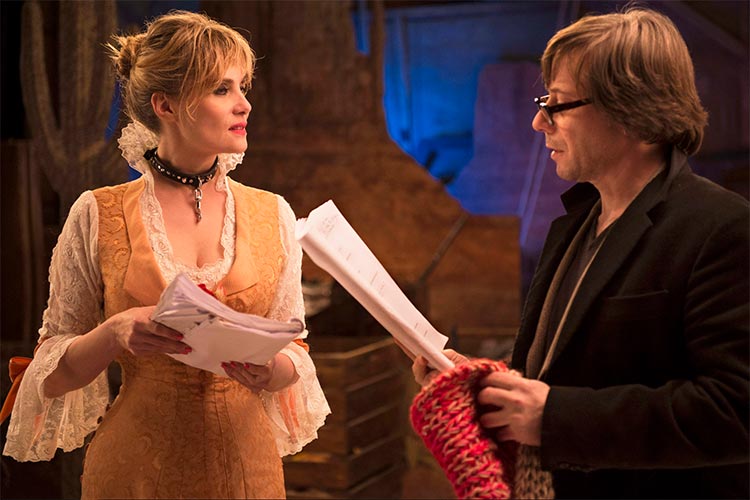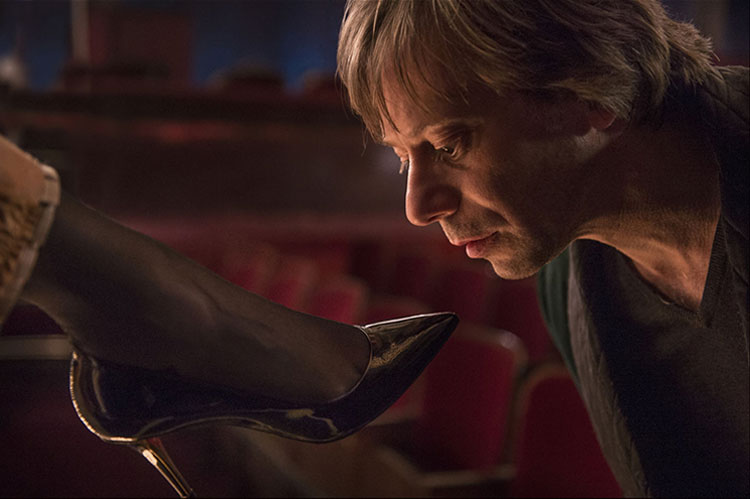By Enrique Pedraza.
“Venus in Fur” is a perfect synthesis of the meaning of the word performance. It is based on a play by David Ives which itself is based on the novella, with the same name, by Leopold Von Sachen-Masoch. The play is about two characters rehearsing for the play titled “Venus in Fur.” The result of these layers being exposed to us on film is evident in the work by actors Emmanuelle Seigner (Vanda) and Mathieu Amalric (Thomas). They are acting for the play in the story as well as acting for Roman Polanski’s film, so the dynamic in their performance is brutally complex and rich in contrast. Both their faces are exciting and weighty.
The film opens with a classic tracking shot in the street as we’re walked through the sidewalk and into a theater. This is the only time we get to see the outside world until the conclusion where the camera gently leaves the theater. After a long day of unsatisfactory auditions for the title female role in a play, Thomas, the director, is getting ready to leave. Vanda enters the theater, soaked in water from the outside rain to unexpectedly audition for the role. The play centers on a woman who enters into agreement with her male counterpart to dominate him as her slave. At first, Vanda (who shares the same character name) seems flashy and completely wrong for a character that is meant to be extremely seductive and enlighten by erotic energy. Once Thomas agrees to let her audition for the role, Vanda transforms into an erogenous beast that allows us to discover the characters outside the play and the true reason Thomas has written the play.

It is exciting and rare to be invested in a piece that features two actors dialoguing in front of the camera. The setting couldn’t be simpler, but the acting couldn’t be more complex. Not only there’s a shift in tone and performance when rehearsing for the play, there’s also the difference in acting style that’s required for theater and film. Aside from that, the story features themes of dominance and superiority that increase the tension and gradually become the center of conflict. Throughout the film, the play becomes real and both Thomas and Vanda invest themselves deeply into their roles and stop rehearsing; they shift the energy in the room and opt for a darker scenario, as they seem to embody the characters fully.
The film is carefully crafted and that’s one of the great things about working with a closed environment and a clear, smaller setting: There is a lot of room for details. Polanski takes advantages of the blending of the different types of performances and gives the film an odd attitude that makes the audience invest their energy in a sensibility that feels extracted from a dream or a fantasy. Part of creating such environment is due to the incredible use of sound design and how, as the actors perform the play, we get to hear the sounds of smaller actions where there are imaginary props. For example, the pouring of water, the folding of letters or the closing of an envelope. Moreover, the music, essential in this film, works beautifully in immersing the audience in the world of Thomas and Vanda, not only to see them transform into their characters, but also to gradually manipulate the mood and make us debate the reality of the circumstances.

“Venus in Fur” is classic in its filmmaking v and in its themes. That sense of superiority and dominance by women has always been an exciting and pleasurable experience for some men, many of them who become addicted to such inferiority. Fetishism plays an important role in the story, also very present in human sexuality and used as a tool for discomfort, becoming great source of fiction towards visual storytelling. The physical conversion of actress Emmanuelle Seigner is so attractive to watch because she slowly becomes this erotic figure that changes the dynamics of the room and intimidates our lead character, someone who is initially superior to her by being the director of the play and the genius behind the story. What a radical, transformative performance the one she gives us.
It was a pleasure seeing a project where the actors are the essential constituents in the success of the final piece. As viewers we’ve always been invested in the art of cinema to participate in other humans’ stories and their view of life. This is the reason why we see films: We are curious and extremely protective of our opinions, so we want to see others express themselves and live similar things so we can identify and feel we belong somewhere. “Venus in Fur” is a beautiful example of an immersive, itemized director who takes on his sole responsibility on set: Get the best actors and let them perform freely. This will always work, undeniably.
“Venus in Fur” is playing on VOD and select theaters, please check your local listings.





